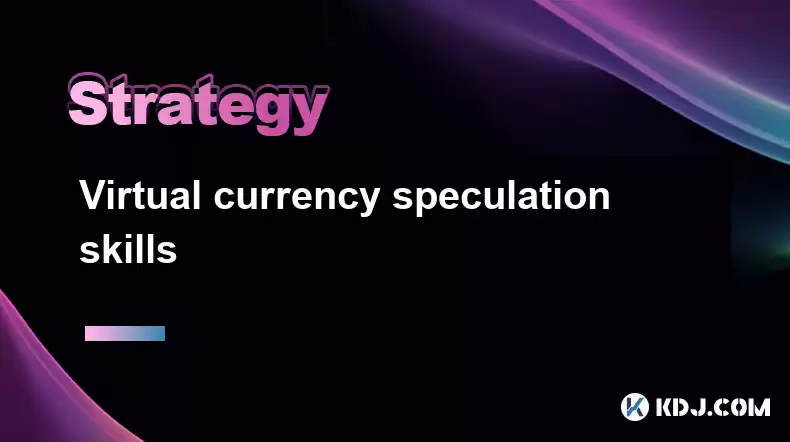-
 bitcoin
bitcoin $121833.232455 USD
-0.63% -
 ethereum
ethereum $4394.437030 USD
-2.00% -
 tether
tether $1.000570 USD
0.04% -
 bnb
bnb $1255.553465 USD
-3.73% -
 xrp
xrp $2.814944 USD
-1.59% -
 solana
solana $221.835346 USD
-2.40% -
 usd-coin
usd-coin $0.999869 USD
0.01% -
 dogecoin
dogecoin $0.249495 USD
-1.32% -
 tron
tron $0.336905 USD
-1.24% -
 cardano
cardano $0.816464 USD
-1.69% -
 chainlink
chainlink $22.130946 USD
-1.27% -
 hyperliquid
hyperliquid $44.208522 USD
-3.46% -
 ethena-usde
ethena-usde $1.000521 USD
0.02% -
 sui
sui $3.422897 USD
-2.51% -
 stellar
stellar $0.380164 USD
-1.31%
Virtual currency speculation skills
By understanding cryptocurrency markets, utilizing risk management strategies, employing technical analysis techniques, conducting fundamental analysis, and monitoring market news, individuals can develop the necessary skills to navigate the volatile world of virtual currency speculation.
Jan 08, 2025 at 07:06 am

Virtual Currency Speculation Skills: A Comprehensive Guide for Cryptocurrency Investors
- Understanding Cryptocurrency Markets: Exploring blockchain technology and decentralized finance, recognizing market cycles and trends, monitoring crypto exchanges and liquidity pools.
- Risk Management Strategies: Managing volatility by setting stop-loss orders, diversifying investments, understanding leverage and margin trading, practicing prudent risk appetite assessment.
- Technical Analysis Techniques: Chart patterns, moving averages, technical indicators (stochastic oscillator, RSI, MACD), candlestick analysis, Fibonacci retracement for price prediction.
- Fundamental Analysis Fundamentals: Evaluating project whitepapers and roadmaps, understanding tokenomics and use cases, monitoring team behind projects, assessing real-world applications.
- Market News and Sentiment Analysis: Staying informed about industry developments, analyzing social media trends, following expert opinions, assessing regulatory updates.
Key Points of Virtual Currency Speculation Skills
1. Understanding Cryptocurrency Markets- Grasp the basics of blockchain technology, decentralized finance, and cryptocurrency markets.
- Study historical price charts to identify market cycles and trends.
- Utilize trading volume indicators and liquidity pools to assess market depth and volatility.
- Implement stop-loss orders to limit potential losses.
- Diversify investments across multiple cryptocurrencies and exchanges.
- Understand leverage and margin trading for advanced risk-reward strategies.
- Assess personal risk appetite and invest accordingly.
- Identify chart patterns, such as head and shoulders, triangles, and pennants.
- Utilize moving averages to determine market trends and support/resistance levels.
- Leverage technical indicators (e.g., stochastic oscillator, RSI, MACD) to assess momentum and overbought/oversold conditions.
- Apply Fibonacci retracement levels to predict potential price targets.
- Thoroughly read project whitepapers and roadmaps to understand project vision and objectives.
- Analyze tokenomics, including token supply, distribution, and use cases.
- Research the team behind the project, their experience, and track record.
- Evaluate real-world applications and potential adoption of the cryptocurrency.
- Stay abreast of industry news and announcements through reputable sources.
- Monitor social media platforms (e.g., Twitter, Reddit) to gauge sentiment and identify emerging trends.
- Follow expert opinions and market analysts for insights into potential price movements.
- Keep track of regulatory updates and their impact on cryptocurrency markets.
FAQs on Virtual Currency Speculation Skills
1. What are the key qualities of a successful cryptocurrency speculator?- Strong understanding of market fundamentals and technical analysis
- Effective risk management skills
- Ability to analyze market trends and make informed decisions
- Patience and discipline to withstand market volatility
- Constant learning and adaptation to the evolving cryptocurrency landscape
- Emotional trading and FOMO (fear of missing out)
- Overleveraging and taking on excessive risk
- Investing in poorly researched or speculative projects
- Lack of understanding of the underlying technology and market dynamics
- Ignoring stop-loss orders and failing to manage risk effectively
Disclaimer:info@kdj.com
The information provided is not trading advice. kdj.com does not assume any responsibility for any investments made based on the information provided in this article. Cryptocurrencies are highly volatile and it is highly recommended that you invest with caution after thorough research!
If you believe that the content used on this website infringes your copyright, please contact us immediately (info@kdj.com) and we will delete it promptly.
- Bitcoin, Trump, and Trade Wars: Retaliation Rattles the Crypto Market
- 2025-10-11 08:25:15
- Global Banks, G7 Stablecoins, and Exploration: Charting the Future of Finance
- 2025-10-11 08:25:15
- Morgan Stanley, Crypto, and the Gates of Mainstream Adoption
- 2025-10-11 08:30:01
- Donald Trump, Tariffs, and Signaling Back: A New Era of Trade Wars?
- 2025-10-11 08:30:01
- Navigating the Crypto Tide: From Fading Wallet Tokens to the Rise of LivLive and BNB Memecoins in '25
- 2025-10-11 08:30:01
- Roughrider Coin: Fiserv and North Dakota's Bold Stablecoin Leap
- 2025-10-11 08:30:16
Related knowledge

Practical parameter settings for a Bitcoin multi-timeframe moving average system
Sep 18,2025 at 10:54pm
Optimizing Timeframe Combinations for Bitcoin Trading1. Selecting appropriate timeframes is crucial when building a multi-timeframe moving average sys...

How can I filter out false breakouts in Dogecoin high-frequency trading?
Sep 22,2025 at 01:00am
Understanding False Breakouts in Dogecoin Trading1. A false breakout occurs when Dogecoin's price appears to move beyond a defined support or resistan...

Techniques for identifying tops and bottoms in the Bitcoin on-chain NVT model
Sep 20,2025 at 07:54pm
Understanding the NVT Model in Bitcoin Analysis1. The Network Value to Transactions (NVT) ratio is often described as the 'P/E ratio' of the cryptocur...

What does the surge in open interest in Bitcoincoin futures mean?
Sep 20,2025 at 11:18pm
Understanding the Surge in Dogecoin Futures Open Interest1. A surge in open interest within Dogecoin futures indicates a growing number of active cont...

How can I use the Ethereum USDT premium to gauge market sentiment?
Sep 18,2025 at 11:55pm
Understanding the Ethereum USDT Premium1. The Ethereum USDT premium refers to the price difference between USDT (Tether) traded on Ethereum-based plat...

What should I do if Ethereum staking yields decline?
Sep 20,2025 at 06:18am
Understanding the Causes Behind Declining Ethereum Staking Yields1. The Ethereum network transitioned to a proof-of-stake consensus mechanism with the...

Practical parameter settings for a Bitcoin multi-timeframe moving average system
Sep 18,2025 at 10:54pm
Optimizing Timeframe Combinations for Bitcoin Trading1. Selecting appropriate timeframes is crucial when building a multi-timeframe moving average sys...

How can I filter out false breakouts in Dogecoin high-frequency trading?
Sep 22,2025 at 01:00am
Understanding False Breakouts in Dogecoin Trading1. A false breakout occurs when Dogecoin's price appears to move beyond a defined support or resistan...

Techniques for identifying tops and bottoms in the Bitcoin on-chain NVT model
Sep 20,2025 at 07:54pm
Understanding the NVT Model in Bitcoin Analysis1. The Network Value to Transactions (NVT) ratio is often described as the 'P/E ratio' of the cryptocur...

What does the surge in open interest in Bitcoincoin futures mean?
Sep 20,2025 at 11:18pm
Understanding the Surge in Dogecoin Futures Open Interest1. A surge in open interest within Dogecoin futures indicates a growing number of active cont...

How can I use the Ethereum USDT premium to gauge market sentiment?
Sep 18,2025 at 11:55pm
Understanding the Ethereum USDT Premium1. The Ethereum USDT premium refers to the price difference between USDT (Tether) traded on Ethereum-based plat...

What should I do if Ethereum staking yields decline?
Sep 20,2025 at 06:18am
Understanding the Causes Behind Declining Ethereum Staking Yields1. The Ethereum network transitioned to a proof-of-stake consensus mechanism with the...
See all articles










































































